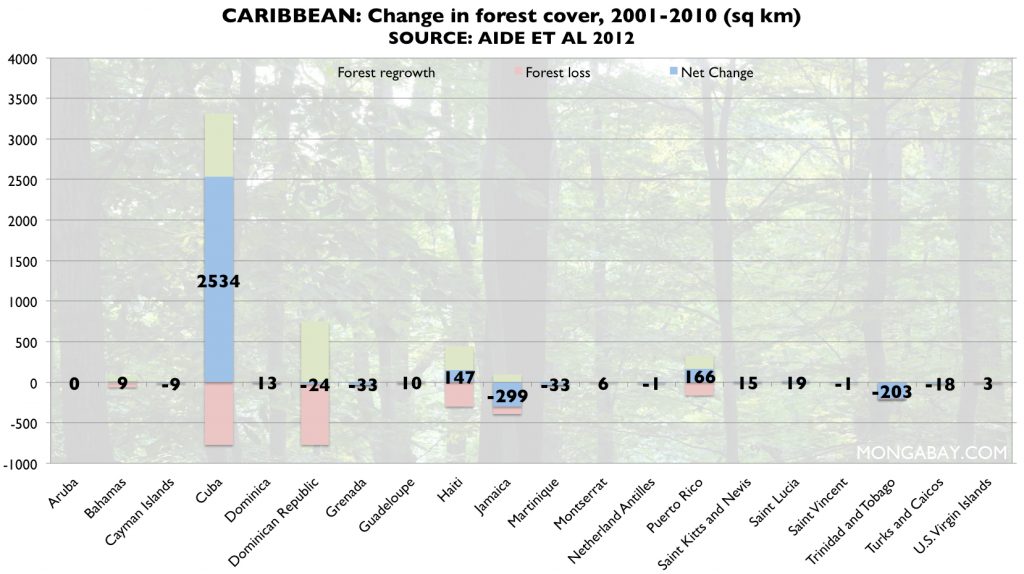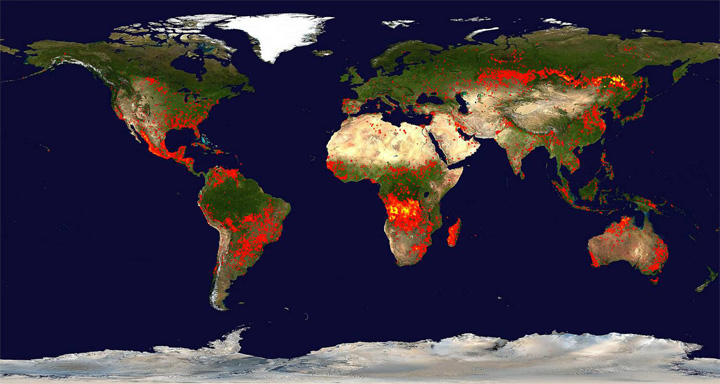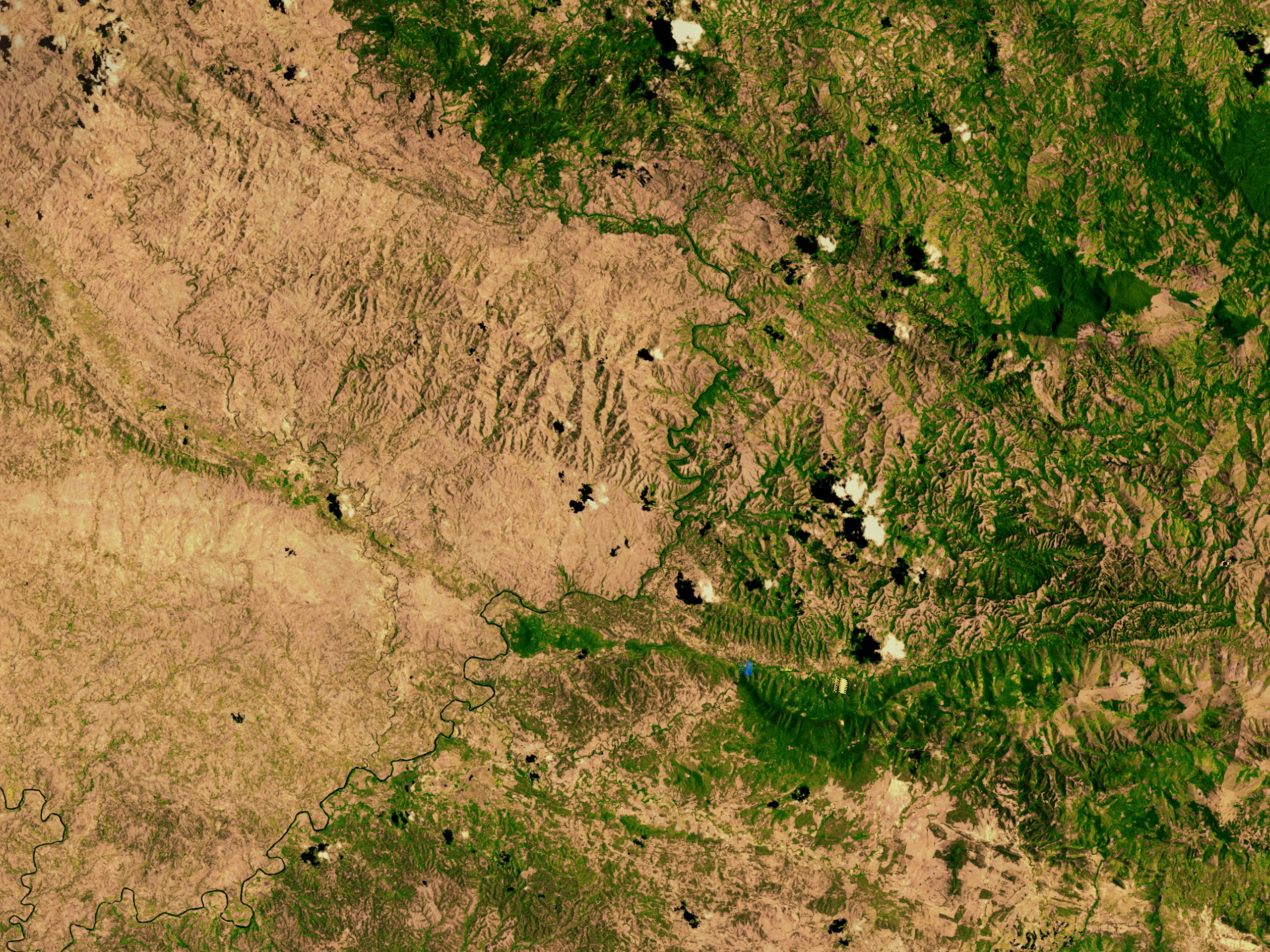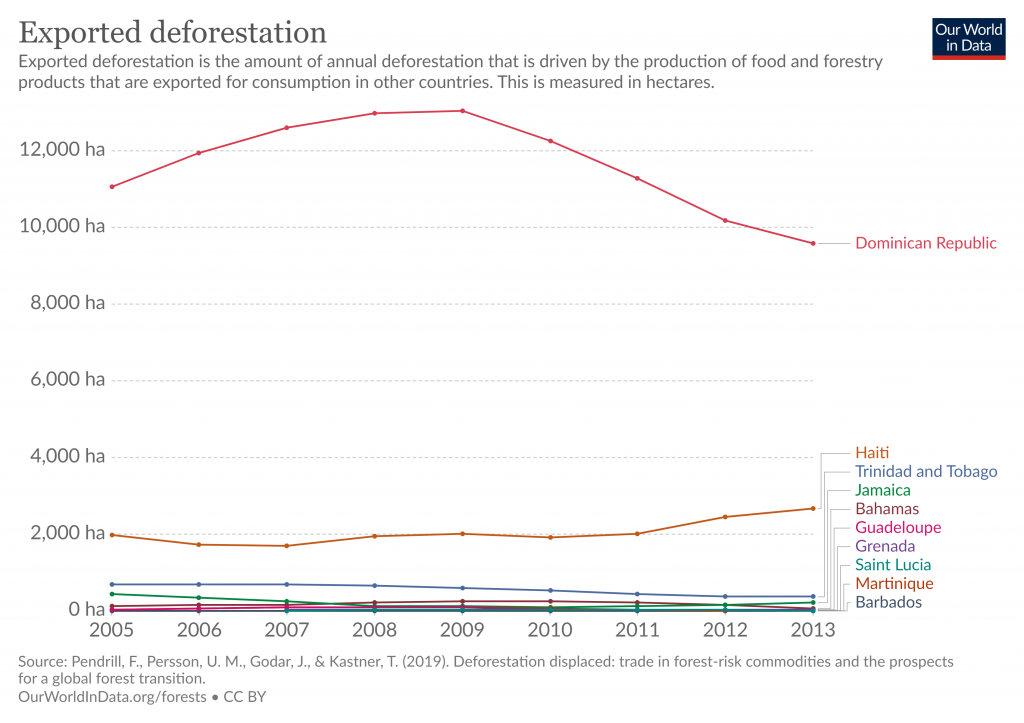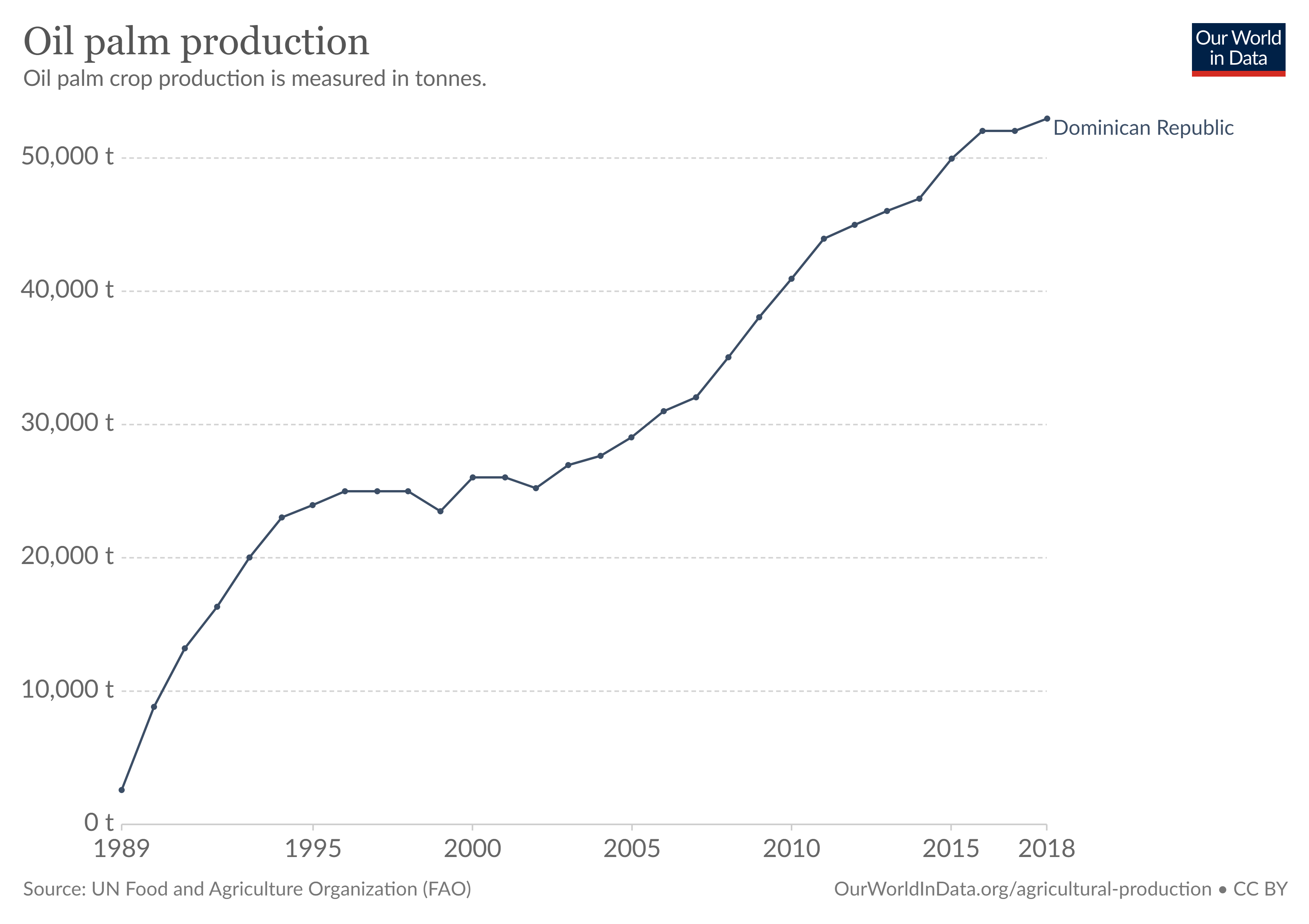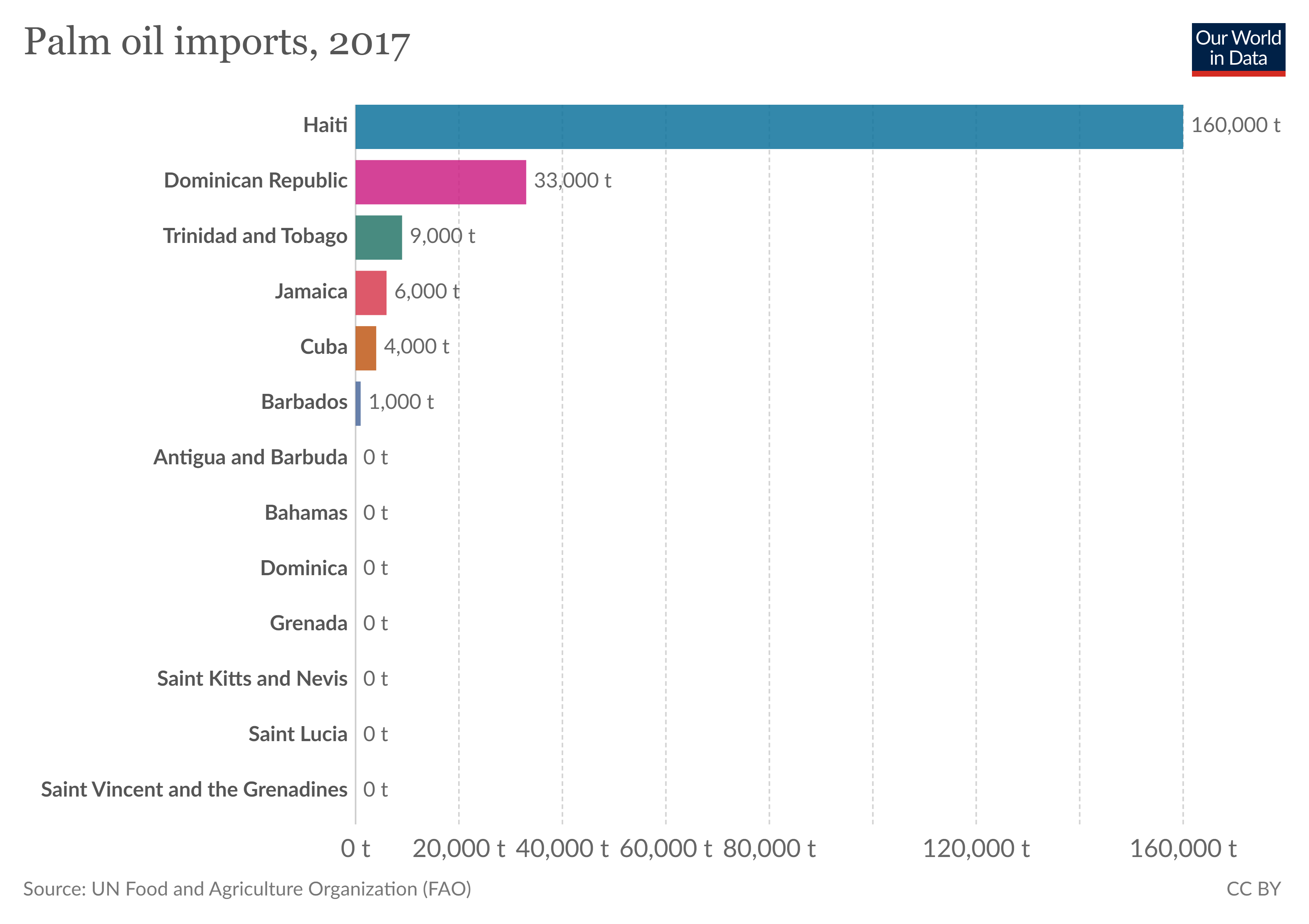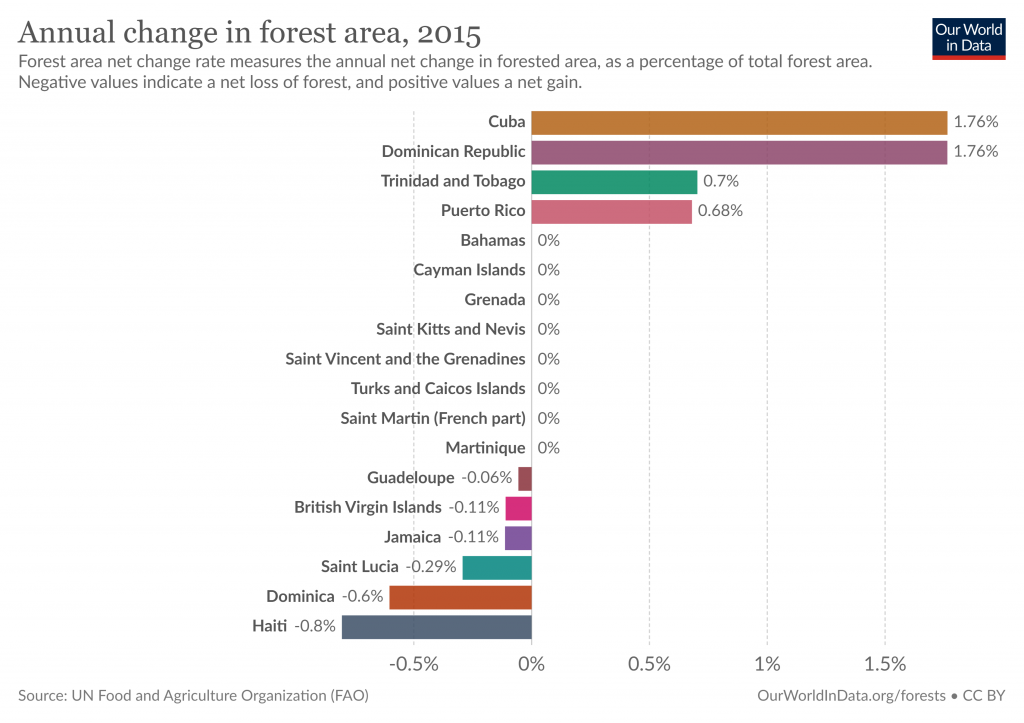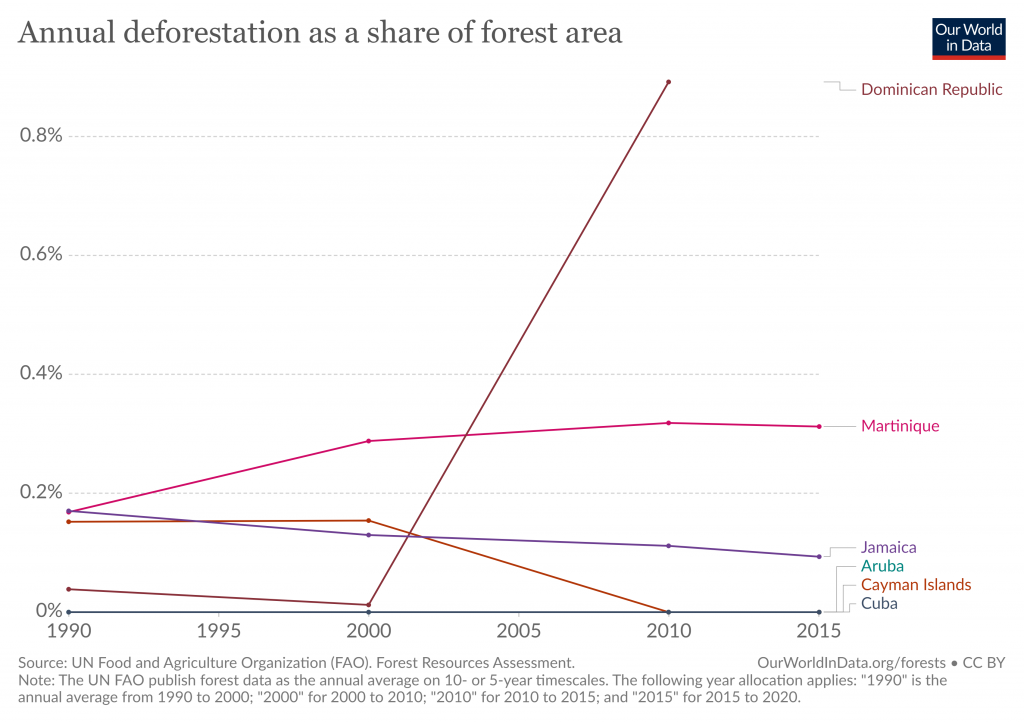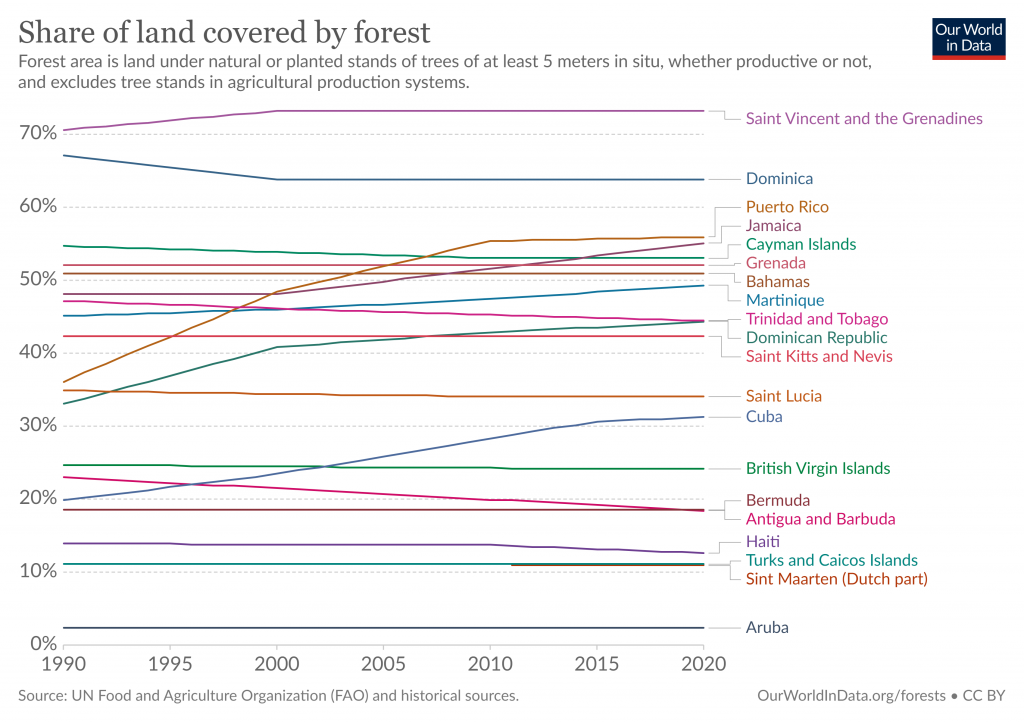7. Deforestation Not too far in the distant past deforestation was measured in ha/year. It is now measured in ha/week. A large percentage of land on the islands is privately-owned and this is where much of the forests are being cleared for private and commercial development. Clearing for human settlements (this includes squatting), infrastructure, commercial activities (this includes the illegal cultivation of marijuana), bauxite mining, quarrying, charcoal burning, illegal timber harvesting, and damage by hurricanes are among the factors currently contributing to deforestation and forest degradation in the region (FAO UN, 2014).
Mangroves, not normally associated with deforestation, are just as important to the ecosystem. They are being removed by selective logging (legal and illegal), reclamation for land use, and conversion to profitable land use such as tourism. Removing mangroves affects the coastal regions, all fauna inhabiting the mangrove forests, and removes the weather barriers that offer protection against extreme natural events.
Forest cover change differs among the various islands and states. The reasons for this vary from agriculture, mining, illegal timber removal, charcoal production, private and commercial construction, tourism accommodation in the form of hotels, casinos, golf courses, hurricane damage – the list goes on. The point here being the island nations are feeling the effects of growing national debt, the loss of tourism and the income generated by the tourism industry.
Net gain and loss of forest per island. Jamaica has less than 25% (8% according to the FAO UN, 2014) of its natural forest left; the majority of it is fragmented secondary growth with untouched areas in the inaccessible mountainous regions. Tourism, bauxite mining and agriculture are the largest income producers for the country. Bauxite mining is the number one cause for the high deforestation rate as seen in the graph above. Once roads are cleared to provide access to the mining areas the coal burners, loggers and yam stick traders move in and further decimate the trees in & around the mining areas.
Satellite image of heat from deforestation. Source: CommunityCarbonTrees.Org One of the most hideous examples of deforestation is the country of Haiti. Less than 1% of its original old growth forest remains in hard to reach mountainous regions. With the lack of forest cover in Haiti, it has become a nation of on-going mass extinction. To witness this in real time is a tragedy beyond comprehension.
The border between Haiti and the Dominican Republic is clearly delineated by the lack of trees on the side of Haiti. Source: NASA
The Dominican Republic, at present, seems to be the only country that has opted to deforest for Palm Oil. While not undergoing deforestation for Palm Oil, these countries are contributing to deforestation elsewhere by importing Palm Oil. An excellent expose on the rampant illegal burning and clearing of Sierra de Bahoruco National Park habitat in the Dominican Republic can be read here .
Citations
{2129430:XBQNHH94};{2129430:LHQ34MUW};{2129430:R7TSN58L}
apa
default
asc
no
13313 %7B%22status%22%3A%22success%22%2C%22updateneeded%22%3Afalse%2C%22instance%22%3A%22zotpress-e0c18631b0a9eaa3bf1ce012ec169e82%22%2C%22meta%22%3A%7B%22request_last%22%3A0%2C%22request_next%22%3A0%2C%22used_cache%22%3Atrue%7D%2C%22data%22%3A%5B%7B%22key%22%3A%22LHQ34MUW%22%2C%22library%22%3A%7B%22id%22%3A2129430%7D%2C%22meta%22%3A%7B%22creatorSummary%22%3A%22Hedges%20et%20al.%22%2C%22parsedDate%22%3A%222018-10-29%22%2C%22numChildren%22%3A1%7D%2C%22bib%22%3A%22%3Cdiv%20class%3D%5C%22csl-bib-body%5C%22%20style%3D%5C%22line-height%3A%202%3B%20padding-left%3A%201em%3B%20text-indent%3A-1em%3B%5C%22%3E%5Cn%20%20%3Cdiv%20class%3D%5C%22csl-entry%5C%22%3EHedges%2C%20S.%20B.%2C%20Cohen%2C%20W.%20B.%2C%20Timyan%2C%20J.%2C%20%26amp%3B%20Yang%2C%20Z.%20%282018%29.%20Haiti%26%23x2019%3Bs%20biodiversity%20threatened%20by%20nearly%20complete%20loss%20of%20primary%20forest.%20%3Ci%3EProceedings%20of%20the%20National%20Academy%20of%20Sciences%3C%5C%2Fi%3E%2C%20201809753.%20%3Ca%20href%3D%27https%3A%5C%2F%5C%2Fdoi.org%5C%2F10.1073%5C%2Fpnas.1809753115%27%3Ehttps%3A%5C%2F%5C%2Fdoi.org%5C%2F10.1073%5C%2Fpnas.1809753115%3C%5C%2Fa%3E%3C%5C%2Fdiv%3E%5Cn%3C%5C%2Fdiv%3E%22%2C%22data%22%3A%7B%22itemType%22%3A%22journalArticle%22%2C%22title%22%3A%22Haiti%5Cu2019s%20biodiversity%20threatened%20by%20nearly%20complete%20loss%20of%20primary%20forest%22%2C%22creators%22%3A%5B%7B%22creatorType%22%3A%22author%22%2C%22firstName%22%3A%22S.%20Blair%22%2C%22lastName%22%3A%22Hedges%22%7D%2C%7B%22creatorType%22%3A%22author%22%2C%22firstName%22%3A%22Warren%20B.%22%2C%22lastName%22%3A%22Cohen%22%7D%2C%7B%22creatorType%22%3A%22author%22%2C%22firstName%22%3A%22Joel%22%2C%22lastName%22%3A%22Timyan%22%7D%2C%7B%22creatorType%22%3A%22author%22%2C%22firstName%22%3A%22Zhiqiang%22%2C%22lastName%22%3A%22Yang%22%7D%5D%2C%22abstractNote%22%3A%22%22%2C%22date%22%3A%222018-10-29%22%2C%22language%22%3A%22en%22%2C%22DOI%22%3A%2210.1073%5C%2Fpnas.1809753115%22%2C%22ISSN%22%3A%220027-8424%2C%201091-6490%22%2C%22url%22%3A%22http%3A%5C%2F%5C%2Fwww.pnas.org%5C%2Flookup%5C%2Fdoi%5C%2F10.1073%5C%2Fpnas.1809753115%22%2C%22collections%22%3A%5B%224E2FHAKS%22%5D%2C%22dateModified%22%3A%222018-11-05T16%3A24%3A49Z%22%7D%7D%2C%7B%22key%22%3A%22XBQNHH94%22%2C%22library%22%3A%7B%22id%22%3A2129430%7D%2C%22meta%22%3A%7B%22creatorSummary%22%3A%22Ramachandran%20and%20Walz%22%2C%22parsedDate%22%3A%222015%22%2C%22numChildren%22%3A0%7D%2C%22bib%22%3A%22%3Cdiv%20class%3D%5C%22csl-bib-body%5C%22%20style%3D%5C%22line-height%3A%202%3B%20padding-left%3A%201em%3B%20text-indent%3A-1em%3B%5C%22%3E%5Cn%20%20%3Cdiv%20class%3D%5C%22csl-entry%5C%22%3ERamachandran%2C%20V.%2C%20%26amp%3B%20Walz%2C%20J.%20%282015%29.%20Haiti%3A%20where%20has%20all%20the%20money%20gone%3F%20%3Ci%3EJournal%20of%20Haitian%20Studies%3C%5C%2Fi%3E%2C%20%3Ci%3E21%3C%5C%2Fi%3E%281%29%2C%2026%26%23x2013%3B65.%3C%5C%2Fdiv%3E%5Cn%3C%5C%2Fdiv%3E%22%2C%22data%22%3A%7B%22itemType%22%3A%22journalArticle%22%2C%22title%22%3A%22Haiti%3A%20where%20has%20all%20the%20money%20gone%3F%22%2C%22creators%22%3A%5B%7B%22creatorType%22%3A%22author%22%2C%22firstName%22%3A%22Vijaya%22%2C%22lastName%22%3A%22Ramachandran%22%7D%2C%7B%22creatorType%22%3A%22author%22%2C%22firstName%22%3A%22Julie%22%2C%22lastName%22%3A%22Walz%22%7D%5D%2C%22abstractNote%22%3A%22%22%2C%22date%22%3A%222015%22%2C%22language%22%3A%22%22%2C%22DOI%22%3A%22%22%2C%22ISSN%22%3A%22%22%2C%22url%22%3A%22%22%2C%22collections%22%3A%5B%224E2FHAKS%22%5D%2C%22dateModified%22%3A%222018-03-08T21%3A56%3A43Z%22%7D%7D%2C%7B%22key%22%3A%22R7TSN58L%22%2C%22library%22%3A%7B%22id%22%3A2129430%7D%2C%22meta%22%3A%7B%22creatorSummary%22%3A%22Laurance%20et%20al.%22%2C%22parsedDate%22%3A%222012%22%2C%22numChildren%22%3A0%7D%2C%22bib%22%3A%22%3Cdiv%20class%3D%5C%22csl-bib-body%5C%22%20style%3D%5C%22line-height%3A%202%3B%20padding-left%3A%201em%3B%20text-indent%3A-1em%3B%5C%22%3E%5Cn%20%20%3Cdiv%20class%3D%5C%22csl-entry%5C%22%3ELaurance%2C%20W.%20F.%2C%20Carolina%20Useche%2C%20D.%2C%20Rendeiro%2C%20J.%2C%20Kalka%2C%20M.%2C%20Bradshaw%2C%20C.%20J.%20A.%2C%20Sloan%2C%20S.%20P.%2C%20Laurance%2C%20S.%20G.%2C%20Campbell%2C%20M.%2C%20Abernethy%2C%20K.%2C%20Alvarez%2C%20P.%2C%20Arroyo-Rodriguez%2C%20V.%2C%20Ashton%2C%20P.%2C%20Ben%26%23xED%3Btez-Malvido%2C%20J.%2C%20Blom%2C%20A.%2C%20Bobo%2C%20K.%20S.%2C%20Cannon%2C%20C.%20H.%2C%20Cao%2C%20M.%2C%20Carroll%2C%20R.%2C%20Chapman%2C%20C.%2C%20%26%23x2026%3B%20Zamzani%2C%20F.%20%282012%29.%20Averting%20biodiversity%20collapse%20in%20tropical%20forest%20protected%20areas.%20%3Ci%3ENature%3C%5C%2Fi%3E%2C%20%3Ci%3E489%3C%5C%2Fi%3E%287415%29%2C%20290%26%23x2013%3B294.%20%3Ca%20href%3D%27https%3A%5C%2F%5C%2Fdoi.org%5C%2F10.1038%5C%2Fnature11318%27%3Ehttps%3A%5C%2F%5C%2Fdoi.org%5C%2F10.1038%5C%2Fnature11318%3C%5C%2Fa%3E%3C%5C%2Fdiv%3E%5Cn%3C%5C%2Fdiv%3E%22%2C%22data%22%3A%7B%22itemType%22%3A%22journalArticle%22%2C%22title%22%3A%22Averting%20biodiversity%20collapse%20in%20tropical%20forest%20protected%20areas%22%2C%22creators%22%3A%5B%7B%22creatorType%22%3A%22author%22%2C%22firstName%22%3A%22William%20F.%22%2C%22lastName%22%3A%22Laurance%22%7D%2C%7B%22creatorType%22%3A%22author%22%2C%22firstName%22%3A%22D.%22%2C%22lastName%22%3A%22Carolina%20Useche%22%7D%2C%7B%22creatorType%22%3A%22author%22%2C%22firstName%22%3A%22Julio%22%2C%22lastName%22%3A%22Rendeiro%22%7D%2C%7B%22creatorType%22%3A%22author%22%2C%22firstName%22%3A%22Margareta%22%2C%22lastName%22%3A%22Kalka%22%7D%2C%7B%22creatorType%22%3A%22author%22%2C%22firstName%22%3A%22Corey%20J.%20A.%22%2C%22lastName%22%3A%22Bradshaw%22%7D%2C%7B%22creatorType%22%3A%22author%22%2C%22firstName%22%3A%22Sean%20P.%22%2C%22lastName%22%3A%22Sloan%22%7D%2C%7B%22creatorType%22%3A%22author%22%2C%22firstName%22%3A%22Susan%20G.%22%2C%22lastName%22%3A%22Laurance%22%7D%2C%7B%22creatorType%22%3A%22author%22%2C%22firstName%22%3A%22Mason%22%2C%22lastName%22%3A%22Campbell%22%7D%2C%7B%22creatorType%22%3A%22author%22%2C%22firstName%22%3A%22Kate%22%2C%22lastName%22%3A%22Abernethy%22%7D%2C%7B%22creatorType%22%3A%22author%22%2C%22firstName%22%3A%22Patricia%22%2C%22lastName%22%3A%22Alvarez%22%7D%2C%7B%22creatorType%22%3A%22author%22%2C%22firstName%22%3A%22Victor%22%2C%22lastName%22%3A%22Arroyo-Rodriguez%22%7D%2C%7B%22creatorType%22%3A%22author%22%2C%22firstName%22%3A%22Peter%22%2C%22lastName%22%3A%22Ashton%22%7D%2C%7B%22creatorType%22%3A%22author%22%2C%22firstName%22%3A%22Julieta%22%2C%22lastName%22%3A%22Ben%5Cu00edtez-Malvido%22%7D%2C%7B%22creatorType%22%3A%22author%22%2C%22firstName%22%3A%22Allard%22%2C%22lastName%22%3A%22Blom%22%7D%2C%7B%22creatorType%22%3A%22author%22%2C%22firstName%22%3A%22Kadiri%20S.%22%2C%22lastName%22%3A%22Bobo%22%7D%2C%7B%22creatorType%22%3A%22author%22%2C%22firstName%22%3A%22Charles%20H.%22%2C%22lastName%22%3A%22Cannon%22%7D%2C%7B%22creatorType%22%3A%22author%22%2C%22firstName%22%3A%22Min%22%2C%22lastName%22%3A%22Cao%22%7D%2C%7B%22creatorType%22%3A%22author%22%2C%22firstName%22%3A%22Richard%22%2C%22lastName%22%3A%22Carroll%22%7D%2C%7B%22creatorType%22%3A%22author%22%2C%22firstName%22%3A%22Colin%22%2C%22lastName%22%3A%22Chapman%22%7D%2C%7B%22creatorType%22%3A%22author%22%2C%22firstName%22%3A%22Rosamond%22%2C%22lastName%22%3A%22Coates%22%7D%2C%7B%22creatorType%22%3A%22author%22%2C%22firstName%22%3A%22Marina%22%2C%22lastName%22%3A%22Cords%22%7D%2C%7B%22creatorType%22%3A%22author%22%2C%22firstName%22%3A%22Finn%22%2C%22lastName%22%3A%22Danielsen%22%7D%2C%7B%22creatorType%22%3A%22author%22%2C%22firstName%22%3A%22Bart%22%2C%22lastName%22%3A%22De%20Dijn%22%7D%2C%7B%22creatorType%22%3A%22author%22%2C%22firstName%22%3A%22Eric%22%2C%22lastName%22%3A%22Dinerstein%22%7D%2C%7B%22creatorType%22%3A%22author%22%2C%22firstName%22%3A%22Maureen%20A.%22%2C%22lastName%22%3A%22Donnelly%22%7D%2C%7B%22creatorType%22%3A%22author%22%2C%22firstName%22%3A%22David%22%2C%22lastName%22%3A%22Edwards%22%7D%2C%7B%22creatorType%22%3A%22author%22%2C%22firstName%22%3A%22Felicity%22%2C%22lastName%22%3A%22Edwards%22%7D%2C%7B%22creatorType%22%3A%22author%22%2C%22firstName%22%3A%22Nina%22%2C%22lastName%22%3A%22Farwig%22%7D%2C%7B%22creatorType%22%3A%22author%22%2C%22firstName%22%3A%22Peter%22%2C%22lastName%22%3A%22Fashing%22%7D%2C%7B%22creatorType%22%3A%22author%22%2C%22firstName%22%3A%22Pierre-Michel%22%2C%22lastName%22%3A%22Forget%22%7D%2C%7B%22creatorType%22%3A%22author%22%2C%22firstName%22%3A%22Mercedes%22%2C%22lastName%22%3A%22Foster%22%7D%2C%7B%22creatorType%22%3A%22author%22%2C%22firstName%22%3A%22George%22%2C%22lastName%22%3A%22Gale%22%7D%2C%7B%22creatorType%22%3A%22author%22%2C%22firstName%22%3A%22David%22%2C%22lastName%22%3A%22Harris%22%7D%2C%7B%22creatorType%22%3A%22author%22%2C%22firstName%22%3A%22Rhett%22%2C%22lastName%22%3A%22Harrison%22%7D%2C%7B%22creatorType%22%3A%22author%22%2C%22firstName%22%3A%22John%22%2C%22lastName%22%3A%22Hart%22%7D%2C%7B%22creatorType%22%3A%22author%22%2C%22firstName%22%3A%22Sarah%22%2C%22lastName%22%3A%22Karpanty%22%7D%2C%7B%22creatorType%22%3A%22author%22%2C%22firstName%22%3A%22W.%22%2C%22lastName%22%3A%22John%20Kress%22%7D%2C%7B%22creatorType%22%3A%22author%22%2C%22firstName%22%3A%22Jagdish%22%2C%22lastName%22%3A%22Krishnaswamy%22%7D%2C%7B%22creatorType%22%3A%22author%22%2C%22firstName%22%3A%22Willis%22%2C%22lastName%22%3A%22Logsdon%22%7D%2C%7B%22creatorType%22%3A%22author%22%2C%22firstName%22%3A%22Jon%22%2C%22lastName%22%3A%22Lovett%22%7D%2C%7B%22creatorType%22%3A%22author%22%2C%22firstName%22%3A%22William%22%2C%22lastName%22%3A%22Magnusson%22%7D%2C%7B%22creatorType%22%3A%22author%22%2C%22firstName%22%3A%22Fiona%22%2C%22lastName%22%3A%22Maisels%22%7D%2C%7B%22creatorType%22%3A%22author%22%2C%22firstName%22%3A%22Andrew%20R.%22%2C%22lastName%22%3A%22Marshall%22%7D%2C%7B%22creatorType%22%3A%22author%22%2C%22firstName%22%3A%22Deedra%22%2C%22lastName%22%3A%22McClearn%22%7D%2C%7B%22creatorType%22%3A%22author%22%2C%22firstName%22%3A%22Divya%22%2C%22lastName%22%3A%22Mudappa%22%7D%2C%7B%22creatorType%22%3A%22author%22%2C%22firstName%22%3A%22Martin%20R.%22%2C%22lastName%22%3A%22Nielsen%22%7D%2C%7B%22creatorType%22%3A%22author%22%2C%22firstName%22%3A%22Richard%22%2C%22lastName%22%3A%22Pearson%22%7D%2C%7B%22creatorType%22%3A%22author%22%2C%22firstName%22%3A%22Nigel%22%2C%22lastName%22%3A%22Pitman%22%7D%2C%7B%22creatorType%22%3A%22author%22%2C%22firstName%22%3A%22Jan%22%2C%22lastName%22%3A%22van%20der%20Ploeg%22%7D%2C%7B%22creatorType%22%3A%22author%22%2C%22firstName%22%3A%22Andrew%22%2C%22lastName%22%3A%22Plumptre%22%7D%2C%7B%22creatorType%22%3A%22author%22%2C%22firstName%22%3A%22John%22%2C%22lastName%22%3A%22Poulsen%22%7D%2C%7B%22creatorType%22%3A%22author%22%2C%22firstName%22%3A%22Mauricio%22%2C%22lastName%22%3A%22Quesada%22%7D%2C%7B%22creatorType%22%3A%22author%22%2C%22firstName%22%3A%22Hugo%22%2C%22lastName%22%3A%22Rainey%22%7D%2C%7B%22creatorType%22%3A%22author%22%2C%22firstName%22%3A%22Douglas%22%2C%22lastName%22%3A%22Robinson%22%7D%2C%7B%22creatorType%22%3A%22author%22%2C%22firstName%22%3A%22Christiane%22%2C%22lastName%22%3A%22Roetgers%22%7D%2C%7B%22creatorType%22%3A%22author%22%2C%22firstName%22%3A%22Francesco%22%2C%22lastName%22%3A%22Rovero%22%7D%2C%7B%22creatorType%22%3A%22author%22%2C%22firstName%22%3A%22Frederick%22%2C%22lastName%22%3A%22Scatena%22%7D%2C%7B%22creatorType%22%3A%22author%22%2C%22firstName%22%3A%22Christian%22%2C%22lastName%22%3A%22Schulze%22%7D%2C%7B%22creatorType%22%3A%22author%22%2C%22firstName%22%3A%22Douglas%22%2C%22lastName%22%3A%22Sheil%22%7D%2C%7B%22creatorType%22%3A%22author%22%2C%22firstName%22%3A%22Thomas%22%2C%22lastName%22%3A%22Struhsaker%22%7D%2C%7B%22creatorType%22%3A%22author%22%2C%22firstName%22%3A%22John%22%2C%22lastName%22%3A%22Terborgh%22%7D%2C%7B%22creatorType%22%3A%22author%22%2C%22firstName%22%3A%22Duncan%22%2C%22lastName%22%3A%22Thomas%22%7D%2C%7B%22creatorType%22%3A%22author%22%2C%22firstName%22%3A%22Robert%22%2C%22lastName%22%3A%22Timm%22%7D%2C%7B%22creatorType%22%3A%22author%22%2C%22firstName%22%3A%22J.%22%2C%22lastName%22%3A%22Nicolas%20Urbina-Cardona%22%7D%2C%7B%22creatorType%22%3A%22author%22%2C%22firstName%22%3A%22Karthikeyan%22%2C%22lastName%22%3A%22Vasudevan%22%7D%2C%7B%22creatorType%22%3A%22author%22%2C%22firstName%22%3A%22S.%22%2C%22lastName%22%3A%22Joseph%20Wright%22%7D%2C%7B%22creatorType%22%3A%22author%22%2C%22firstName%22%3A%22Juan%22%2C%22lastName%22%3A%22Carlos%20Arias-G.%22%7D%2C%7B%22creatorType%22%3A%22author%22%2C%22firstName%22%3A%22Luzmila%22%2C%22lastName%22%3A%22Arroyo%22%7D%2C%7B%22creatorType%22%3A%22author%22%2C%22firstName%22%3A%22Mark%22%2C%22lastName%22%3A%22Ashton%22%7D%2C%7B%22creatorType%22%3A%22author%22%2C%22firstName%22%3A%22Philippe%22%2C%22lastName%22%3A%22Auzel%22%7D%2C%7B%22creatorType%22%3A%22author%22%2C%22firstName%22%3A%22Dennis%22%2C%22lastName%22%3A%22Babaasa%22%7D%2C%7B%22creatorType%22%3A%22author%22%2C%22firstName%22%3A%22Fred%22%2C%22lastName%22%3A%22Babweteera%22%7D%2C%7B%22creatorType%22%3A%22author%22%2C%22firstName%22%3A%22Patrick%22%2C%22lastName%22%3A%22Baker%22%7D%2C%7B%22creatorType%22%3A%22author%22%2C%22firstName%22%3A%22Olaf%22%2C%22lastName%22%3A%22Banki%22%7D%2C%7B%22creatorType%22%3A%22author%22%2C%22firstName%22%3A%22Margot%22%2C%22lastName%22%3A%22Bass%22%7D%2C%7B%22creatorType%22%3A%22author%22%2C%22firstName%22%3A%22Inogwabini%22%2C%22lastName%22%3A%22Bila-Isia%22%7D%2C%7B%22creatorType%22%3A%22author%22%2C%22firstName%22%3A%22Stephen%22%2C%22lastName%22%3A%22Blake%22%7D%2C%7B%22creatorType%22%3A%22author%22%2C%22firstName%22%3A%22Warren%22%2C%22lastName%22%3A%22Brockelman%22%7D%2C%7B%22creatorType%22%3A%22author%22%2C%22firstName%22%3A%22Nicholas%22%2C%22lastName%22%3A%22Brokaw%22%7D%2C%7B%22creatorType%22%3A%22author%22%2C%22firstName%22%3A%22Carsten%20A.%22%2C%22lastName%22%3A%22Br%5Cu00fchl%22%7D%2C%7B%22creatorType%22%3A%22author%22%2C%22firstName%22%3A%22Sarayudh%22%2C%22lastName%22%3A%22Bunyavejchewin%22%7D%2C%7B%22creatorType%22%3A%22author%22%2C%22firstName%22%3A%22Jung-Tai%22%2C%22lastName%22%3A%22Chao%22%7D%2C%7B%22creatorType%22%3A%22author%22%2C%22firstName%22%3A%22Jerome%22%2C%22lastName%22%3A%22Chave%22%7D%2C%7B%22creatorType%22%3A%22author%22%2C%22firstName%22%3A%22Ravi%22%2C%22lastName%22%3A%22Chellam%22%7D%2C%7B%22creatorType%22%3A%22author%22%2C%22firstName%22%3A%22Connie%20J.%22%2C%22lastName%22%3A%22Clark%22%7D%2C%7B%22creatorType%22%3A%22author%22%2C%22firstName%22%3A%22Jos%5Cu00e9%22%2C%22lastName%22%3A%22Clavijo%22%7D%2C%7B%22creatorType%22%3A%22author%22%2C%22firstName%22%3A%22Robert%22%2C%22lastName%22%3A%22Congdon%22%7D%2C%7B%22creatorType%22%3A%22author%22%2C%22firstName%22%3A%22Richard%22%2C%22lastName%22%3A%22Corlett%22%7D%2C%7B%22creatorType%22%3A%22author%22%2C%22firstName%22%3A%22H.%20S.%22%2C%22lastName%22%3A%22Dattaraja%22%7D%2C%7B%22creatorType%22%3A%22author%22%2C%22firstName%22%3A%22Chittaranjan%22%2C%22lastName%22%3A%22Dave%22%7D%2C%7B%22creatorType%22%3A%22author%22%2C%22firstName%22%3A%22Glyn%22%2C%22lastName%22%3A%22Davies%22%7D%2C%7B%22creatorType%22%3A%22author%22%2C%22firstName%22%3A%22Beatriz%22%2C%22lastName%22%3A%22de%20Mello%20Beisiegel%22%7D%2C%7B%22creatorType%22%3A%22author%22%2C%22firstName%22%3A%22Rosa%22%2C%22lastName%22%3A%22de%20Nazar%5Cu00e9%20Paes%20da%20Silva%22%7D%2C%7B%22creatorType%22%3A%22author%22%2C%22firstName%22%3A%22Anthony%22%2C%22lastName%22%3A%22Di%20Fiore%22%7D%2C%7B%22creatorType%22%3A%22author%22%2C%22firstName%22%3A%22Arvin%22%2C%22lastName%22%3A%22Diesmos%22%7D%2C%7B%22creatorType%22%3A%22author%22%2C%22firstName%22%3A%22Rodolfo%22%2C%22lastName%22%3A%22Dirzo%22%7D%2C%7B%22creatorType%22%3A%22author%22%2C%22firstName%22%3A%22Diane%22%2C%22lastName%22%3A%22Doran-Sheehy%22%7D%2C%7B%22creatorType%22%3A%22author%22%2C%22firstName%22%3A%22Mitchell%22%2C%22lastName%22%3A%22Eaton%22%7D%2C%7B%22creatorType%22%3A%22author%22%2C%22firstName%22%3A%22Louise%22%2C%22lastName%22%3A%22Emmons%22%7D%2C%7B%22creatorType%22%3A%22author%22%2C%22firstName%22%3A%22Alejandro%22%2C%22lastName%22%3A%22Estrada%22%7D%2C%7B%22creatorType%22%3A%22author%22%2C%22firstName%22%3A%22Corneille%22%2C%22lastName%22%3A%22Ewango%22%7D%2C%7B%22creatorType%22%3A%22author%22%2C%22firstName%22%3A%22Linda%22%2C%22lastName%22%3A%22Fedigan%22%7D%2C%7B%22creatorType%22%3A%22author%22%2C%22firstName%22%3A%22Fran%5Cu00e7ois%22%2C%22lastName%22%3A%22Feer%22%7D%2C%7B%22creatorType%22%3A%22author%22%2C%22firstName%22%3A%22Barbara%22%2C%22lastName%22%3A%22Fruth%22%7D%2C%7B%22creatorType%22%3A%22author%22%2C%22firstName%22%3A%22Jacalyn%22%2C%22lastName%22%3A%22Giacalone%20Willis%22%7D%2C%7B%22creatorType%22%3A%22author%22%2C%22firstName%22%3A%22Uromi%22%2C%22lastName%22%3A%22Goodale%22%7D%2C%7B%22creatorType%22%3A%22author%22%2C%22firstName%22%3A%22Steven%22%2C%22lastName%22%3A%22Goodman%22%7D%2C%7B%22creatorType%22%3A%22author%22%2C%22firstName%22%3A%22Juan%20C.%22%2C%22lastName%22%3A%22Guix%22%7D%2C%7B%22creatorType%22%3A%22author%22%2C%22firstName%22%3A%22Paul%22%2C%22lastName%22%3A%22Guthiga%22%7D%2C%7B%22creatorType%22%3A%22author%22%2C%22firstName%22%3A%22William%22%2C%22lastName%22%3A%22Haber%22%7D%2C%7B%22creatorType%22%3A%22author%22%2C%22firstName%22%3A%22Keith%22%2C%22lastName%22%3A%22Hamer%22%7D%2C%7B%22creatorType%22%3A%22author%22%2C%22firstName%22%3A%22Ilka%22%2C%22lastName%22%3A%22Herbinger%22%7D%2C%7B%22creatorType%22%3A%22author%22%2C%22firstName%22%3A%22Jane%22%2C%22lastName%22%3A%22Hill%22%7D%2C%7B%22creatorType%22%3A%22author%22%2C%22firstName%22%3A%22Zhongliang%22%2C%22lastName%22%3A%22Huang%22%7D%2C%7B%22creatorType%22%3A%22author%22%2C%22firstName%22%3A%22I%22%2C%22lastName%22%3A%22Fang%20Sun%22%7D%2C%7B%22creatorType%22%3A%22author%22%2C%22firstName%22%3A%22Kalan%22%2C%22lastName%22%3A%22Ickes%22%7D%2C%7B%22creatorType%22%3A%22author%22%2C%22firstName%22%3A%22Akira%22%2C%22lastName%22%3A%22Itoh%22%7D%2C%7B%22creatorType%22%3A%22author%22%2C%22firstName%22%3A%22Nat%5Cu00e1lia%22%2C%22lastName%22%3A%22Ivanauskas%22%7D%2C%7B%22creatorType%22%3A%22author%22%2C%22firstName%22%3A%22Betsy%22%2C%22lastName%22%3A%22Jackes%22%7D%2C%7B%22creatorType%22%3A%22author%22%2C%22firstName%22%3A%22John%22%2C%22lastName%22%3A%22Janovec%22%7D%2C%7B%22creatorType%22%3A%22author%22%2C%22firstName%22%3A%22Daniel%22%2C%22lastName%22%3A%22Janzen%22%7D%2C%7B%22creatorType%22%3A%22author%22%2C%22firstName%22%3A%22Mo%22%2C%22lastName%22%3A%22Jiangming%22%7D%2C%7B%22creatorType%22%3A%22author%22%2C%22firstName%22%3A%22Chen%22%2C%22lastName%22%3A%22Jin%22%7D%2C%7B%22creatorType%22%3A%22author%22%2C%22firstName%22%3A%22Trevor%22%2C%22lastName%22%3A%22Jones%22%7D%2C%7B%22creatorType%22%3A%22author%22%2C%22firstName%22%3A%22Hermes%22%2C%22lastName%22%3A%22Justiniano%22%7D%2C%7B%22creatorType%22%3A%22author%22%2C%22firstName%22%3A%22Elisabeth%22%2C%22lastName%22%3A%22Kalko%22%7D%2C%7B%22creatorType%22%3A%22author%22%2C%22firstName%22%3A%22Aventino%22%2C%22lastName%22%3A%22Kasangaki%22%7D%2C%7B%22creatorType%22%3A%22author%22%2C%22firstName%22%3A%22Timothy%22%2C%22lastName%22%3A%22Killeen%22%7D%2C%7B%22creatorType%22%3A%22author%22%2C%22firstName%22%3A%22Hen-biau%22%2C%22lastName%22%3A%22King%22%7D%2C%7B%22creatorType%22%3A%22author%22%2C%22firstName%22%3A%22Erik%22%2C%22lastName%22%3A%22Klop%22%7D%2C%7B%22creatorType%22%3A%22author%22%2C%22firstName%22%3A%22Cheryl%22%2C%22lastName%22%3A%22Knott%22%7D%2C%7B%22creatorType%22%3A%22author%22%2C%22firstName%22%3A%22Inza%22%2C%22lastName%22%3A%22Kon%5Cu00e9%22%7D%2C%7B%22creatorType%22%3A%22author%22%2C%22firstName%22%3A%22Enoka%22%2C%22lastName%22%3A%22Kudavidanage%22%7D%2C%7B%22creatorType%22%3A%22author%22%2C%22firstName%22%3A%22Jos%5Cu00e9%22%2C%22lastName%22%3A%22Lahoz%20da%20Silva%20Ribeiro%22%7D%2C%7B%22creatorType%22%3A%22author%22%2C%22firstName%22%3A%22John%22%2C%22lastName%22%3A%22Lattke%22%7D%2C%7B%22creatorType%22%3A%22author%22%2C%22firstName%22%3A%22Richard%22%2C%22lastName%22%3A%22Laval%22%7D%2C%7B%22creatorType%22%3A%22author%22%2C%22firstName%22%3A%22Robert%22%2C%22lastName%22%3A%22Lawton%22%7D%2C%7B%22creatorType%22%3A%22author%22%2C%22firstName%22%3A%22Miguel%22%2C%22lastName%22%3A%22Leal%22%7D%2C%7B%22creatorType%22%3A%22author%22%2C%22firstName%22%3A%22Mark%22%2C%22lastName%22%3A%22Leighton%22%7D%2C%7B%22creatorType%22%3A%22author%22%2C%22firstName%22%3A%22Miguel%22%2C%22lastName%22%3A%22Lentino%22%7D%2C%7B%22creatorType%22%3A%22author%22%2C%22firstName%22%3A%22Cristiane%22%2C%22lastName%22%3A%22Leonel%22%7D%2C%7B%22creatorType%22%3A%22author%22%2C%22firstName%22%3A%22Jeremy%22%2C%22lastName%22%3A%22Lindsell%22%7D%2C%7B%22creatorType%22%3A%22author%22%2C%22firstName%22%3A%22Lee%22%2C%22lastName%22%3A%22Ling-Ling%22%7D%2C%7B%22creatorType%22%3A%22author%22%2C%22firstName%22%3A%22K.%22%2C%22lastName%22%3A%22Eduard%20Linsenmair%22%7D%2C%7B%22creatorType%22%3A%22author%22%2C%22firstName%22%3A%22Elizabeth%22%2C%22lastName%22%3A%22Losos%22%7D%2C%7B%22creatorType%22%3A%22author%22%2C%22firstName%22%3A%22Ariel%22%2C%22lastName%22%3A%22Lugo%22%7D%2C%7B%22creatorType%22%3A%22author%22%2C%22firstName%22%3A%22Jeremiah%22%2C%22lastName%22%3A%22Lwanga%22%7D%2C%7B%22creatorType%22%3A%22author%22%2C%22firstName%22%3A%22Andrew%20L.%22%2C%22lastName%22%3A%22Mack%22%7D%2C%7B%22creatorType%22%3A%22author%22%2C%22firstName%22%3A%22Marlucia%22%2C%22lastName%22%3A%22Martins%22%7D%2C%7B%22creatorType%22%3A%22author%22%2C%22firstName%22%3A%22W.%22%2C%22lastName%22%3A%22Scott%20McGraw%22%7D%2C%7B%22creatorType%22%3A%22author%22%2C%22firstName%22%3A%22Roan%22%2C%22lastName%22%3A%22McNab%22%7D%2C%7B%22creatorType%22%3A%22author%22%2C%22firstName%22%3A%22Luciano%22%2C%22lastName%22%3A%22Montag%22%7D%2C%7B%22creatorType%22%3A%22author%22%2C%22firstName%22%3A%22Jo%22%2C%22lastName%22%3A%22Myers%20Thompson%22%7D%2C%7B%22creatorType%22%3A%22author%22%2C%22firstName%22%3A%22Jacob%22%2C%22lastName%22%3A%22Nabe-Nielsen%22%7D%2C%7B%22creatorType%22%3A%22author%22%2C%22firstName%22%3A%22Michiko%22%2C%22lastName%22%3A%22Nakagawa%22%7D%2C%7B%22creatorType%22%3A%22author%22%2C%22firstName%22%3A%22Sanjay%22%2C%22lastName%22%3A%22Nepal%22%7D%2C%7B%22creatorType%22%3A%22author%22%2C%22firstName%22%3A%22Marilyn%22%2C%22lastName%22%3A%22Norconk%22%7D%2C%7B%22creatorType%22%3A%22author%22%2C%22firstName%22%3A%22Vojtech%22%2C%22lastName%22%3A%22Novotny%22%7D%2C%7B%22creatorType%22%3A%22author%22%2C%22firstName%22%3A%22Sean%22%2C%22lastName%22%3A%22O%27Donnell%22%7D%2C%7B%22creatorType%22%3A%22author%22%2C%22firstName%22%3A%22Muse%22%2C%22lastName%22%3A%22Opiang%22%7D%2C%7B%22creatorType%22%3A%22author%22%2C%22firstName%22%3A%22Paul%22%2C%22lastName%22%3A%22Ouboter%22%7D%2C%7B%22creatorType%22%3A%22author%22%2C%22firstName%22%3A%22Kenneth%22%2C%22lastName%22%3A%22Parker%22%7D%2C%7B%22creatorType%22%3A%22author%22%2C%22firstName%22%3A%22N.%22%2C%22lastName%22%3A%22Parthasarathy%22%7D%2C%7B%22creatorType%22%3A%22author%22%2C%22firstName%22%3A%22K%5Cu00e1tia%22%2C%22lastName%22%3A%22Pisciotta%22%7D%2C%7B%22creatorType%22%3A%22author%22%2C%22firstName%22%3A%22Dewi%22%2C%22lastName%22%3A%22Prawiradilaga%22%7D%2C%7B%22creatorType%22%3A%22author%22%2C%22firstName%22%3A%22Catherine%22%2C%22lastName%22%3A%22Pringle%22%7D%2C%7B%22creatorType%22%3A%22author%22%2C%22firstName%22%3A%22Subaraj%22%2C%22lastName%22%3A%22Rajathurai%22%7D%2C%7B%22creatorType%22%3A%22author%22%2C%22firstName%22%3A%22Ulrich%22%2C%22lastName%22%3A%22Reichard%22%7D%2C%7B%22creatorType%22%3A%22author%22%2C%22firstName%22%3A%22Gay%22%2C%22lastName%22%3A%22Reinartz%22%7D%2C%7B%22creatorType%22%3A%22author%22%2C%22firstName%22%3A%22Katherine%22%2C%22lastName%22%3A%22Renton%22%7D%2C%7B%22creatorType%22%3A%22author%22%2C%22firstName%22%3A%22Glen%22%2C%22lastName%22%3A%22Reynolds%22%7D%2C%7B%22creatorType%22%3A%22author%22%2C%22firstName%22%3A%22Vernon%22%2C%22lastName%22%3A%22Reynolds%22%7D%2C%7B%22creatorType%22%3A%22author%22%2C%22firstName%22%3A%22Erin%22%2C%22lastName%22%3A%22Riley%22%7D%2C%7B%22creatorType%22%3A%22author%22%2C%22firstName%22%3A%22Mark-Oliver%22%2C%22lastName%22%3A%22R%5Cu00f6del%22%7D%2C%7B%22creatorType%22%3A%22author%22%2C%22firstName%22%3A%22Jessica%22%2C%22lastName%22%3A%22Rothman%22%7D%2C%7B%22creatorType%22%3A%22author%22%2C%22firstName%22%3A%22Philip%22%2C%22lastName%22%3A%22Round%22%7D%2C%7B%22creatorType%22%3A%22author%22%2C%22firstName%22%3A%22Shoko%22%2C%22lastName%22%3A%22Sakai%22%7D%2C%7B%22creatorType%22%3A%22author%22%2C%22firstName%22%3A%22Tania%22%2C%22lastName%22%3A%22Sanaiotti%22%7D%2C%7B%22creatorType%22%3A%22author%22%2C%22firstName%22%3A%22Tommaso%22%2C%22lastName%22%3A%22Savini%22%7D%2C%7B%22creatorType%22%3A%22author%22%2C%22firstName%22%3A%22Gertrud%22%2C%22lastName%22%3A%22Schaab%22%7D%2C%7B%22creatorType%22%3A%22author%22%2C%22firstName%22%3A%22John%22%2C%22lastName%22%3A%22Seidensticker%22%7D%2C%7B%22creatorType%22%3A%22author%22%2C%22firstName%22%3A%22Alhaji%22%2C%22lastName%22%3A%22Siaka%22%7D%2C%7B%22creatorType%22%3A%22author%22%2C%22firstName%22%3A%22Miles%20R.%22%2C%22lastName%22%3A%22Silman%22%7D%2C%7B%22creatorType%22%3A%22author%22%2C%22firstName%22%3A%22Thomas%20B.%22%2C%22lastName%22%3A%22Smith%22%7D%2C%7B%22creatorType%22%3A%22author%22%2C%22firstName%22%3A%22Samuel%20Soares%22%2C%22lastName%22%3A%22de%20Almeida%22%7D%2C%7B%22creatorType%22%3A%22author%22%2C%22firstName%22%3A%22Navjot%22%2C%22lastName%22%3A%22Sodhi%22%7D%2C%7B%22creatorType%22%3A%22author%22%2C%22firstName%22%3A%22Craig%22%2C%22lastName%22%3A%22Stanford%22%7D%2C%7B%22creatorType%22%3A%22author%22%2C%22firstName%22%3A%22Kristine%22%2C%22lastName%22%3A%22Stewart%22%7D%2C%7B%22creatorType%22%3A%22author%22%2C%22firstName%22%3A%22Emma%22%2C%22lastName%22%3A%22Stokes%22%7D%2C%7B%22creatorType%22%3A%22author%22%2C%22firstName%22%3A%22Kathryn%20E.%22%2C%22lastName%22%3A%22Stoner%22%7D%2C%7B%22creatorType%22%3A%22author%22%2C%22firstName%22%3A%22Raman%22%2C%22lastName%22%3A%22Sukumar%22%7D%2C%7B%22creatorType%22%3A%22author%22%2C%22firstName%22%3A%22Martin%22%2C%22lastName%22%3A%22Surbeck%22%7D%2C%7B%22creatorType%22%3A%22author%22%2C%22firstName%22%3A%22Mathias%22%2C%22lastName%22%3A%22Tobler%22%7D%2C%7B%22creatorType%22%3A%22author%22%2C%22firstName%22%3A%22Teja%22%2C%22lastName%22%3A%22Tscharntke%22%7D%2C%7B%22creatorType%22%3A%22author%22%2C%22firstName%22%3A%22Andrea%22%2C%22lastName%22%3A%22Turkalo%22%7D%2C%7B%22creatorType%22%3A%22author%22%2C%22firstName%22%3A%22Govindaswamy%22%2C%22lastName%22%3A%22Umapathy%22%7D%2C%7B%22creatorType%22%3A%22author%22%2C%22firstName%22%3A%22Merlijn%22%2C%22lastName%22%3A%22van%20Weerd%22%7D%2C%7B%22creatorType%22%3A%22author%22%2C%22firstName%22%3A%22Jorge%22%2C%22lastName%22%3A%22Vega%20Rivera%22%7D%2C%7B%22creatorType%22%3A%22author%22%2C%22firstName%22%3A%22Meena%22%2C%22lastName%22%3A%22Venkataraman%22%7D%2C%7B%22creatorType%22%3A%22author%22%2C%22firstName%22%3A%22Linda%22%2C%22lastName%22%3A%22Venn%22%7D%2C%7B%22creatorType%22%3A%22author%22%2C%22firstName%22%3A%22Carlos%22%2C%22lastName%22%3A%22Verea%22%7D%2C%7B%22creatorType%22%3A%22author%22%2C%22firstName%22%3A%22Carolina%22%2C%22lastName%22%3A%22Volkmer%20de%20Castilho%22%7D%2C%7B%22creatorType%22%3A%22author%22%2C%22firstName%22%3A%22Matthias%22%2C%22lastName%22%3A%22Waltert%22%7D%2C%7B%22creatorType%22%3A%22author%22%2C%22firstName%22%3A%22Benjamin%22%2C%22lastName%22%3A%22Wang%22%7D%2C%7B%22creatorType%22%3A%22author%22%2C%22firstName%22%3A%22David%22%2C%22lastName%22%3A%22Watts%22%7D%2C%7B%22creatorType%22%3A%22author%22%2C%22firstName%22%3A%22William%22%2C%22lastName%22%3A%22Weber%22%7D%2C%7B%22creatorType%22%3A%22author%22%2C%22firstName%22%3A%22Paige%22%2C%22lastName%22%3A%22West%22%7D%2C%7B%22creatorType%22%3A%22author%22%2C%22firstName%22%3A%22David%22%2C%22lastName%22%3A%22Whitacre%22%7D%2C%7B%22creatorType%22%3A%22author%22%2C%22firstName%22%3A%22Ken%22%2C%22lastName%22%3A%22Whitney%22%7D%2C%7B%22creatorType%22%3A%22author%22%2C%22firstName%22%3A%22David%22%2C%22lastName%22%3A%22Wilkie%22%7D%2C%7B%22creatorType%22%3A%22author%22%2C%22firstName%22%3A%22Stephen%22%2C%22lastName%22%3A%22Williams%22%7D%2C%7B%22creatorType%22%3A%22author%22%2C%22firstName%22%3A%22Debra%20D.%22%2C%22lastName%22%3A%22Wright%22%7D%2C%7B%22creatorType%22%3A%22author%22%2C%22firstName%22%3A%22Patricia%22%2C%22lastName%22%3A%22Wright%22%7D%2C%7B%22creatorType%22%3A%22author%22%2C%22firstName%22%3A%22Lu%22%2C%22lastName%22%3A%22Xiankai%22%7D%2C%7B%22creatorType%22%3A%22author%22%2C%22firstName%22%3A%22Pralad%22%2C%22lastName%22%3A%22Yonzon%22%7D%2C%7B%22creatorType%22%3A%22author%22%2C%22firstName%22%3A%22Franky%22%2C%22lastName%22%3A%22Zamzani%22%7D%5D%2C%22abstractNote%22%3A%22%22%2C%22date%22%3A%229%5C%2F2012%22%2C%22language%22%3A%22en%22%2C%22DOI%22%3A%2210.1038%5C%2Fnature11318%22%2C%22ISSN%22%3A%220028-0836%2C%201476-4687%22%2C%22url%22%3A%22http%3A%5C%2F%5C%2Fwww.nature.com%5C%2Farticles%5C%2Fnature11318%22%2C%22collections%22%3A%5B%224E2FHAKS%22%5D%2C%22dateModified%22%3A%222018-02-28T10%3A03%3A49Z%22%7D%7D%5D%7D Hedges, S. B., Cohen, W. B., Timyan, J., & Yang, Z. (2018). Haiti’s biodiversity threatened by nearly complete loss of primary forest.
Proceedings of the National Academy of Sciences , 201809753.
https://doi.org/10.1073/pnas.1809753115 Ramachandran, V., & Walz, J. (2015). Haiti: where has all the money gone? Journal of Haitian Studies , 21 (1), 26–65.
Laurance, W. F., Carolina Useche, D., Rendeiro, J., Kalka, M., Bradshaw, C. J. A., Sloan, S. P., Laurance, S. G., Campbell, M., Abernethy, K., Alvarez, P., Arroyo-Rodriguez, V., Ashton, P., Benítez-Malvido, J., Blom, A., Bobo, K. S., Cannon, C. H., Cao, M., Carroll, R., Chapman, C., … Zamzani, F. (2012). Averting biodiversity collapse in tropical forest protected areas.
Nature ,
489 (7415), 290–294.
https://doi.org/10.1038/nature11318 